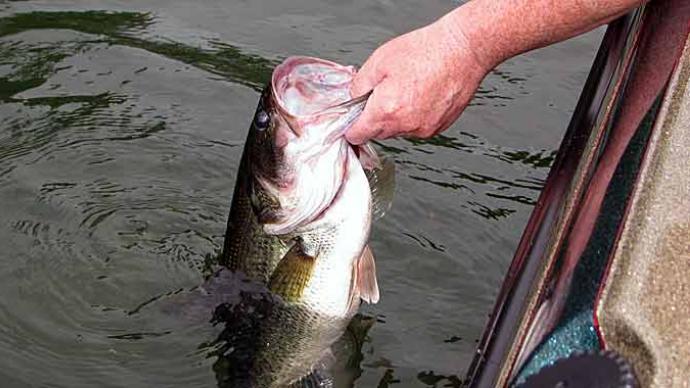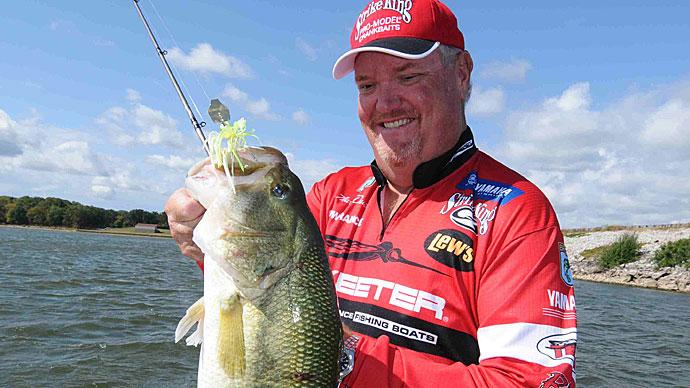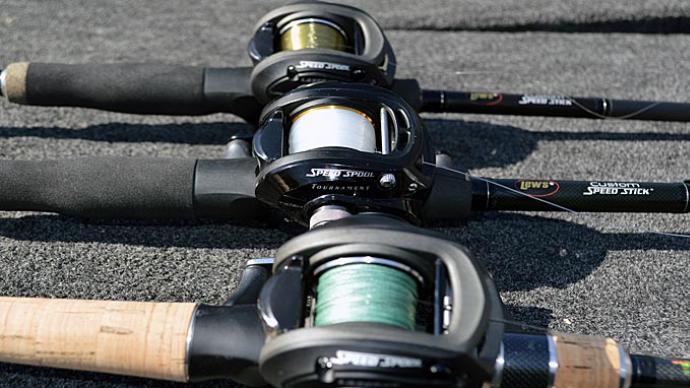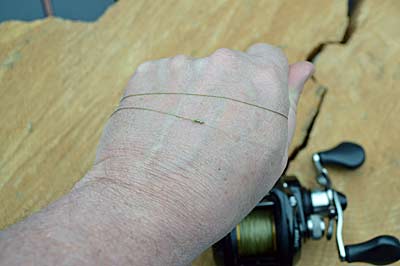
Bass fishing is filled with variables: Season, weather, water type, and forage are just the start. Success comes by correctly responding to where those variables stand, creating the fishing situation that you’re currently facing. Your response starts with picking the best spot, size, action, and color for the lure. That may be sunken brush piles in 15 feet of water on points and a deep diving round-sided crankbait in a baitfish pattern, for example, on a reservoir in summer.
There is one more variable you must solve at least once during each day on the water. And that’s your fishing line's type, strength, and application. It ties everything together. It transmits your pulls, shakes, and hops to your lure, making it attractive to bass. But more importantly, it connects you to the fish, helping you land all that bite your bait.
Choosing the best line and getting the most from it for each fishing situation starts with understanding the types of lines available. The three most popular — braid, monofilament, and fluorocarbon have distinct advantages and disadvantages. And while these differences seem mere inches apart at first, the efficiency that the best one brings can be measured in miles.
Lean On Braid When Things Turn Tough
When it comes to fishing lines, braid is the heavyweight. While it’s available in many strengths, starting with thread-like 5-pound test, its tightly woven strands of supple synthetic materials are nearly indestructible. Combine that with nearly zero stretch, and you have an extremely strong and durable line that’s sensitive and easy to cast.
Image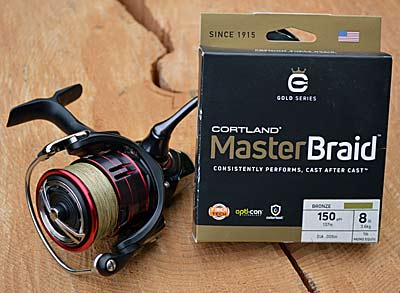
Braid excels in tough situations, which include more than heavy cover. Smaller pound tests have tiny diameters, such as this 8-pound test that matches up with 1-pound test monofilament. That helps you cast lightweight lures further, helping you catch more bass, especially smallmouth, in clear water. Photo by Pete M. Anderson Braid excels in certain situations, from fishing slow-moving lures such as jigs and plastic worms. Its sensitivity will alert you to bites even when your line is slack. And it stands up to heavy cover — brush piles, dock posts, and thick aquatic vegetation — that shred other lines. It also does the best versus the zebra mussel’s razor-sharp edge.
Tough doesn’t always equal heavy cover. In the Great Lakes and other expanses of shallow clear water where giant smallmouth roam, it’s extreme casting distance. Braid is supple, making casting lightweight lures easy; there’s a reason why Great Lakes anglers use it to send 1/16-ounce marabou jigs way out.
Braid pluses:
- Durability: Its synthetic fibers are nearly indestructible. They don't nick or cut easily. It can withstand several seasons of regular fishing before needing replacement.
- Diameter: Compared to other types of lines of the same pound test, the braided line is much thinner. That helps lightweight lures cast further, and diving baits go deeper.
- Sensitive: With nearly zero stretch, braid transmits bites quickly and clearly. Even the lightest nudge feels like a solid thump regardless of depth, current, or how much bow is in your line.
Braid minuses
- Unforgiving: Braid’s lack of stretch can cause trouble. Instead of stretching when a hooked bass lunges, it stands strong. This can pull set hooks, losing bass in the process.
- Visibility: Regardless of its color, braid stands out, especially in clear water. Some anglers embrace that visibility, using it to help detect supple bites. It's concerning to others who add stealth with a monofilament or fluorocarbon leader.
- Expense: Purchasing a spool of braided line is an expensive undertaking. But technology isn’t free. Spreading that cost over several fishing seasons lessens the financial hit.
Try this trick: Sometimes, the color washes out of the last few feet of braided line. Green braid, for example, will turn white. Instead of cutting out that now high-visibility length and retying your lure, run a permanent marker — black, green, or brown — along it, returning it to its camouflaged condition.
Save Monofilament For Moving Baits
Monofilament is a single-strand fishing line that has been around for over a half-century. Countless anglers have used it to catch their first bass and many more. Veteran anglers continue to use it in certain situations because of its characteristics, availability, and cost. If you need a line that will perform day in and day out in various scenarios, then monofilament is your choice.
Monofilament’s slight stretch is a natural for moving baits, especially crankbaits. It allows the bass to inhale your offering with little resistance and absorbs the shocks of a fighting bass. It handles heavy cover well, too. At the same time, most of its stretch disappears as you move to stronger pound tests — 20-pound test or stronger — some remains, cushioning big hooksets with short-line techniques such as flipping. However, its increased diameter makes knot-tying more difficult.
Monofilament pluses
- Cost: Monofilament is the least expensive fishing line, making it easy to keep multiple reels spooled with fresh line. But you get what you pay for, so don’t grab the cheapest one.
- Forgiving: Monofilament has some stretch. That’s handy when fishing lures with treble hooks, which spread your force across multiple points. That give helps keep a lunging or jumping bass hooked.
- Versatility: Widely available in a host of colors and pound tests, monofilament is easy to match to almost any fishing situation. It is also easy to handle and holds fast with almost any knot you tie.
Minuses
- Durability: Monofilament struggles to stand up to abrasion. While some brands tout increased toughness, it’s often best to save this line — especially any rated 15-pound test or less — for sparse cover or open water efforts, such as cranking brush piles on points in summer.
- Stretch: Stretch is a two-way street when it comes to monofilament. While it helps keep bass hooked, extra effort is required to overcome that give when setting the hook, especially at long distances.
- Memory: Monofilament tends to come off the reel in coils. That memory can cause casting struggles, especially with spinning reels. Combat it by replacing your line regularly.
Try this trick: Mind your monofilament’s diameter, especially when spooling it on a casting reel. It can lodge between the spool and frame if it's too small, forcing you to stop and clear it before you can resume fishing. A good rule of thumb is 10-pound test or greater on casting reels.
Fluorocarbon Fishes Right Down The Middle
Many anglers see fluorocarbon as the perfect mix, offering the best traits of braid and monofilament. It’s strong and tough, and it’s nearly invisible under water. That durability makes it sensitive, too; telegraphing bites straight to your hand instead of getting lost somewhere in between.
Image
Fluorocarbon line has the best characteristics of monofilament and fluorocarbon lines. It's strong and tough, standing up to heavy cover. And it's nearly invisible underwater, making it perfect for pursuing line-shy bass in clear water. Photo by Pete M. Anderson Fluorocarbon's combination of strength and invisibility makes it a solid choice in many situations. Many anglers use it for fishing around heavy cover, cranking stumps with a square bill, or pitching a jig to docks. It is also a go-to choice for deep-water smallmouth, whether they're eating a drop-shot or Ned rig.
Unlike monofilament and braid, fluorocarbon comes in one color. Matching the line to conditions isn't necessary because its refractive index is nearly the same as water, allowing it to go undetected even in the clearest water.
Fluorocarbon pluses
- Tough: Fluorocarbon stands up to heavy cover. It’s abrasion-resistant, allowing you to cast your lure into a brush pile, under a dock, or into any other tangled mess with little fear of breaking off a lure or bass.
- Near invisibility: Fluorocarbon disappears under water better than any other line choice. That makes it the clear — pun intended — choice for fishing clear water, where bass can be line shy.
- Sensitivity: Fluorocarbon runs a close second to braid when it comes to sensitivity, whether feeling bites, bottom, or whatever your lure is doing.
Fluorocarbon minuses:
- Density: Fluorocarbon sinks. While that might eke out a few more inches of diving depth from your crankbait, it’s a big issue with topwaters. It can pull one underwater on a long cast.
- Expense: While usually not the same price as braid, fluorocarbon isn’t much cheaper. And it needs more frequent replacement. Purchasing new spools, especially for several reels, can take a bite out of your fishing budget.
Try this trick: Fluorocarbon lacks the flexibility of braid and monofilament. It's a characteristic that becomes more severe as its pound test increases. That can cause line to "explode" off a spinning reel's spool like a spring. If you're dealing with that, switch to a smaller pound test or search for one that's easy to handle, such as Seaguar Tatsu.
Get More Bites With A Leader
Most anglers recognize braid’s many positives. But one of its biggest hangups is visibility, especially when fishing clear water, where it can look like rope. Many turn to adding a leader, whether monofilament or fluorocarbon, to solve that. If that’s your choice, here’s how to do it better.
- Find a good knot: The Double Uni and Crazy Alberto knots are relatively easy to tie and strong. The FG Knot is popular, too. But it takes some practice to tie, especially in the boat, where waves and wind make most tasks more difficult.
- Match sizes: Be sure your leader plays nice with your main line. You don’t want the leader to overpower the mainline. But having a beefier main line than the leader is OK, especially when fishing a rocky bottom. That allows you to easily break off stuck lures or rigs that can't be retrieved.
- Use a long leader: Measuring your leader in feet instead of inches allows you to retie your lure a couple of times without replacing it entirely. The knot you use to attach a lure is much easier and quicker to tie than attaching the leader to the main line.
- But not too long of a leader: Keep your leader short enough so the knot holding it to the main line doesn't repeatedly go through your rod's line guides. That can weaken the knot, causing it to fail at the moment you’re hoping it holds.
- Try it without one: Anglers often find comfort in leaders more than bass. They’re too focused on your lure or wading through too much cover to notice your line. So, if you constantly lean on leaders, try fishing without one. You’ll spend more time fishing and less time tying.
Add Some Backing
Modern reel manufacturers have embraced shallow spools in recent years. They have less mass than traditional deeper versions, making casting reels cast further. And they hold fewer yards, saving you some money when it’s time to load up line. But even if you’re putting less line on, you may need to save room for some backing. It can be the last few yards of a filler spool or the last yards of line closest to the spool. Regardless of its origin, it fills one of two roles:
- Extra grip: Modern braided line is slippery. On a plain metal spool—spinning or casting—it'll slip no matter how tight you tie it. That'll leave you wondering why your reel is turning, but your line isn't. Adding a few wraps, at least enough to cover the spool a couple of layers thick, gives your braid something to bite.
- Space filler: If your reel has a deep spool — enough room for more than 100 yards of 14-pound test monofilament — then backing will save you from replacing line that you never use during a fishing day. And even if you have a shallow spool, small pound test braided lines, for example, have a minuscule diameter. It would take miles of it to fill even a shallow spool, so take up some of that space with backing.
Take Care Of It
Modern fishing line is tough. It handles a wide range of situations and is user-friendly — for the most part. But it isn't bulletproof. You must respect its limitations and give it the best opportunity to succeed. You'll be well on your way to doing that by following these three simple tips.
- Protect it: When not in use, keep your filled reels out of the weather, heat, and sunlight. That'll add longevity to your line, especially those last 50 to 100 feet that are used most. That goes for your filler or bulk spools, too. Inside your vehicle or a boat compartment are the wrong storage spots.
- Spool it: Take your time when filling a reel. Make sure the line lies flat and tight on casting reel spools. It should come off the filler spool in the same direction that it goes on a spinning reel. That will reduce twists, which eventually turn into wind knots and frustration.
- Change it: Everything wears out, even fishing line. Memory eventually makes monofilament and fluorocarbon nightmares to use. Even braid becomes frayed and washed out, though flipping its direction onto a second reel delays replacement. So, put all your reels on a regular re-spooling regime.


